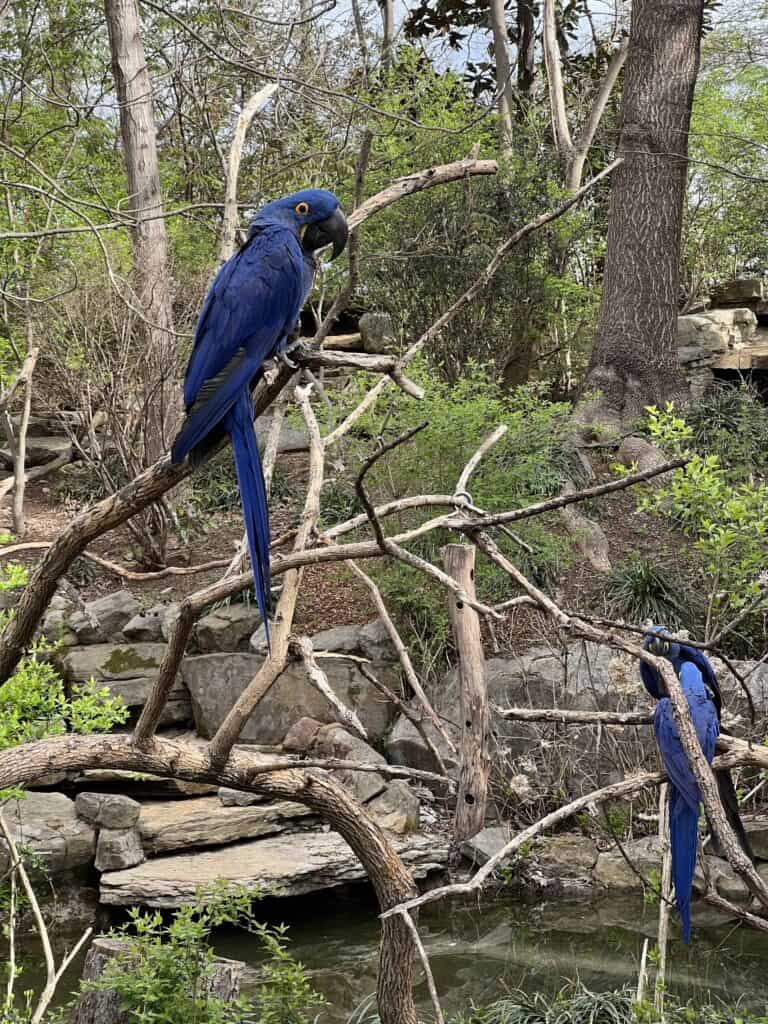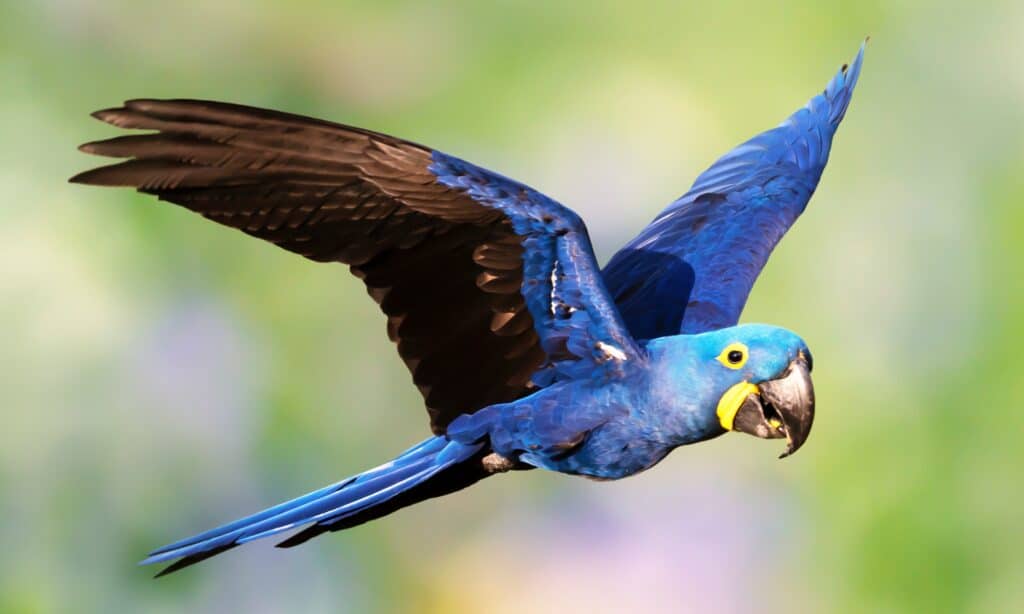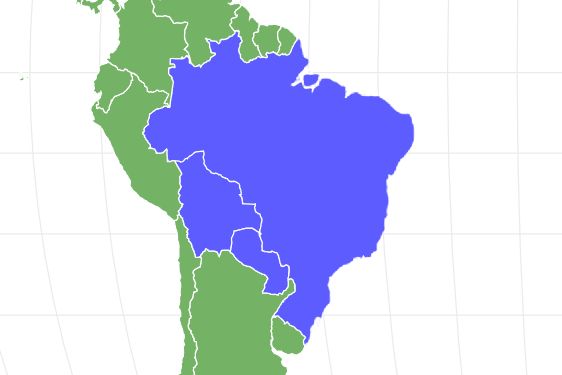Hyacinth Macaw
Anodorhynchus hyacinthinus
The Hyacinth Macaw is the largest flying parrot in the world!
Advertisement
Hyacinth Macaw Scientific Classification
- Kingdom
- Animalia
- Phylum
- Chordata
- Class
- Aves
- Order
- Psittaciformes
- Family
- Psittacidae
- Genus
- Anodorhynchus
- Scientific Name
- Anodorhynchus hyacinthinus
Read our Complete Guide to Classification of Animals.
Hyacinth Macaw Conservation Status
Hyacinth Macaw Facts
- Prey
- Occasionally insects and snails
- Name Of Young
- Chicks or hatchlings
- Group Behavior
- Pair
- Flocks
- Fun Fact
- The Hyacinth Macaw is the largest flying parrot in the world!
- Estimated Population Size
- Approximately 4,300 mature individuals
- Biggest Threat
- Habitat degradation and nest predators
- Most Distinctive Feature
- Bright blue feathers and yellow markings around eyes and chin
- Distinctive Feature
- Large, hooked, black bill; gray under wings and tail; zygodactylous feet
- Temperament
- Somewhat docile, but defensive of nest and feeding area
- Wingspan
- 4 feet or more
- Incubation Period
- 27 to 30 days
- Age Of Independence
- 9 months to 1 year
- Age Of Fledgling
- 105 to 110 days
- Habitat
- Wetlands, lightly wooded areas, grasslands, savannas, shrublands
- Predators
- Toco Toucans, corvids, opossums, and coatis
- Diet
- Omnivore
- Lifestyle
- Diurnal
- Flock
- Pair
- Favorite Food
- Palm nuts, other nuts, large seeds, fruits, occasionally insects and snails
- Number Of Species
- 1
- Location
- Brazil, including the Pantanal wetlands extending into Bolivia and Paraguay
- Average Clutch Size
- 1
- Group
- Flock
- Nesting Location
- High in dead palm trees or Manduvi trees
Hyacinth Macaw Physical Characteristics
- Color
- Grey
- Yellow
- Blue
- Black
- Skin Type
- Feathers
- Top Speed
- 35 mph
- Lifespan
- Up to 60 years or more
- Weight
- 2.5 to 3.75 pounds
- Length
- 39 to 40 inches
- Age of Sexual Maturity
- 7 years
- Venomous
- No
- Aggression
- Low
View all of the Hyacinth Macaw images!
The Hyacinth Macaw is the largest flying parrot in the world!
The Hyacinth Macaw is a beautiful bird, with royal blue plumage, yellow accents around its eyes and beak, and large, graceful looking wings that can extend to a span of four feet or more. Its long tail is pointed and fans out while it is in flight. Its strong, hooked beak is perfectly formed for cracking open tough seeds and nuts, which are the mainstay of its diet. Poachers nearly drove the bird to extinction before it was granted legal protection, and individual birds are still illegally trapped and sold today. However, conservation efforts, particularly in the Pantanal region, are helping to improve the bird’s chances of long term survival.
Incredible Hyacinth Macaw Facts
- Hyacinth Macaws have brilliant royal blue feathers with bright yellow accents around their eyes and lower bill.
- The birds form monogamous pairs that mate for life.
- Hyacinth Macaws spend much of their time grooming and preening themselves and their mates.
- Toco Toucans are the main predators of these macaws. They eat their eggs and nestlings.
- Cattle help process tough seeds that these macaws pluck from their excrement.
- Conservation efforts are helping increase the number of Hyacinth Macaws in the Pantanal wetlands.
Where to Find Hyacinth Macaw
The Hyacinth Macaw lives primarily in Brazil. It is native to three areas, including the world’s largest wetland, the Pantanal. This wetland, and the Hyacinth Macaw’s range, include parts of western Brazil, crossing the borders into Bolivia and Paraguay. The birds also live in parts of the Cerrado savanna in eastern Brazil, north of the Brazilian Highlands in the states of Maranhão, Piauí, Bahia, Tocantins, Goiás, Mato Grosso and Minas Gerais. Finally, they are found in open areas of the eastern Amazon basin in Brazil, including around the Tocantins, Xingu and Tapajós rivers.
Within their range, these large birds live in lightly forested areas, palm swamps, flooded grasslands and savannas. They tend to nest at least 20 to 30 feet off the ground, and utilize particular trees, the Manduvi, also known as the Panama tree, within the Pantanal. Today, more than 75 percent of the estimated population of Hyacinth Macaws live in the Pantanal wetlands.

Hyacinth Macaws, pictured here at
Nashville Zoo at Grassmere
, are the largest known flying parrots in the world.
©
Hyacinth Macaw Scientific Name
The Hyacinth Macaw’s common name is based on the bright blue color of its plumage. Its scientific name is Anodorhynchus hyacinthinus. The genus, Anodorhynchus, derives from Latin and means “bill with no teeth.” The genus includes only one other living species, the Lear’s Macaw, also known as the Indigo Macaw, and a likely extinct species, the Glaucous Macaw. The Lear’s Macaw is very similar in appearance to the Hyacinth Macaw, but it is smaller in size. The Glaucous Macaw, which has not been spotted since the 1980s, was also similar, except it had gray plumage on its head.
Hyacinth Macaws were first described in 1790, by the English ornithologist John Latham. He assigned the name Psittacus hyacinthinus to the bird. It was later reassigned after the genus Anodorhynchus was named in 1824.
Hyacinth Macaw Appearance
Hyacinth Macaws are large birds. In fact, they are the largest known flying parrots in the world. The flightless, green Kākāpō from New Zealand is a heavier bird, sometimes weighing in at more than eight pounds, but it can’t get far off the ground.
The Hyacinth Macaw weighs between 2.5 and 3.75 pounds. From the tip of its beak to the end of its long tail, it can easily reach lengths of up to 40 inches. The bird’s wingspan can exceed four feet, averaging 46 to 50 inches.
These birds, like most macaws, have some of the brightest and most vibrant feathers found in nature. Hyacinth Macaws have royal blue plumage with dark gray under the wings and tail. They have striking yellow accents on either side of their lower bill. These bright yellow markings are echoed in the rings of skin around their black eyes. They have strong, hooked, black bills, and if you look closely, you might be able to spot the bright yellow markings on the sides of their black tongues.
Like other parrots, Hyacinth Macaws have zygodactylous feet. This means that two of their four toes face forward while the other two face back. This is different from the typical songbirds that one might be used to seeing, which have three forward-facing toes and one that faces back.

Close up of a Hyacinth macaw in flight, South Pantanal, Brazil.
©Dgwildlife/Shutterstock.com
Hyacinth Macaws look stunning and graceful in flight, in large part due to their broad wingspan and their long, tapered tail. They fly up to 35 miles per hour, but they are not flappy birds. When landing, they use their expansive wings and tail to steer and glide exactly where they mean to go.
Behavior
Hyacinth Macaws form monogamous pairs and gather in small flocks of up to about eight pairs. They are not known as particularly aggressive birds, although they will vigorously defend both their nests and their feeding areas by swooping at invaders and by loudly squawking while taking on defensive postures. Males will sometimes chase away an intruder by repeatedly jumping at it and using its powerful beak to cause damage if the opponent does not move far enough away.
These birds spend much of their day grooming, cleaning, and preening. They engage in grooming both themselves and their mates. They clean both their feathers and their beaks, and regularly sharpen their beaks against rocks and trees. Preening behavior is most common at dusk and dawn, but it may be done throughout the day.
Diet
The sharp, hooked beak of the Hyacinth Macaw comes in handy when it forages for food. This bird eats nuts from a variety of palms, Brazil nuts, other types of nuts, along with different fruits and vegetables, large seeds, nectar and occasional invertebrates such insects and snails. Some of the nuts and seeds eaten by these macaws would require hammers or other strong tools for a human to open. But they are easy work for a Hyacinth Macaw, which has an incredibly strong beak and a bite force of at least 300 pounds per square inch.
The Hyacinth Macaw’s tongue is specialized for its diet, too. It is long, dry, and scaly, and it has a special bone inside that helps increase its maneuverability. Not only is the bird’s tongue well adapted for eating tough nuts and other foods, but it also allows the bird to mimic many sounds, including human speech.
These birds are messy eaters, and that is important. They often collect seeds or nuts and fly long distances before eating them, spilling portions of their meal on the ground. This method of seed dispersal helps to preserve the population of native, and in some cases, vulnerable plants.
Some of the seeds eaten by Hyacinth Macaws need a little extra processing before the birds can crack them open. Acuri and bocaiuva palm trees provide a large portion of the diet of Hyacinth Macaws living in the Pantanal. The birds rely on the help of cattle, which eat the fruit of these trees and then regurgitate the tough seeds, softening their outer covering. The macaws thrash in the excrement of the cattle, collecting the seeds and eating the insides.
Reproduction
Hyacinth Macaws do not reach their breeding age until they are approximately seven years old. Once they do, they form monogamous pairs and generally mate for life. They are very affectionate and attentive toward one another, and during the breeding season they spend virtually all their time together except for when the male leaves to collect food.
These birds build their nests in tall, mature trees, usually at least 60 years old. In the Pantanal region, they use Manduvi trees almost exclusively. In other areas they mainly nest in large, dead palm trees. They make their nests 20 to 30 feet above the ground. Females lay two to three eggs, but usually have just one chick. A relatively small percentage of the overall population nests during any given breeding season, and of those, an only about 25 percent of the pairs manage to raise a chick successfully.
Females incubate their offspring for a period of about 27 to 30 days. After that, it takes approximately 105 to 110 days for the chick to fledge. The female stays at the nest and tends to the chick during that time. The male brings food to the female and the chick, tends to the grooming of his mate and defends the nest.
Once a Hyacinth Macaw has fledged, it stays close to its parents for a long time. It may stick close to the nest for nine months to a year. During that time, the parents continue to feed and care for it as it approaches full independence.
Predators
Hyacinth Macaws have no known predators as adults, although they do face other threats. However, they are quite vulnerable to nest predators. Some nest predators include corvids, South American opossums, and coatis. Toco Toucans are the primary nest predators of the Hyacinth Macaw. However, the relationship between these two birds is complicated. Although the Toco Toucan is responsible for the highest number of lost eggs and nestlings, it is also the main disperser of Manduvi seeds, the tree that the Hyacinth Macaw nests in and needs for survival.
Lifespan of the Hyacinth Macaw
The Hyacinth Macaw lives a long time. It can live 60 years or more, but their population has been decreasing for decades. They are listed as a vulnerable species on the IUCN Red List of Threatened Species. The estimated total population of Hyacinth Macaws, according to the most recent survey, is 4,300 mature individuals. Approximately 75 percent of the existing population lives in the Pantanal wetlands in Brazil and small parts of adjacent Bolivia and Paraguay.
Conservation Efforts
Human activities are among the greatest threats to the survival of Hyacinth Macaws. Trapping and removal could have driven the birds to extinction had it not been given legal protection in 1987, being added to the Convention on International Trade in Endangered Species, or CITES, list. More than 10,000 individual birds were harvested in the 1980s alone, and they are still being taken illegally by poachers, but the protection has helped.
Cattle ranching, deforestation, and fires have all taken tolls on the habitat of the Hyacinth Macaw. Conservation efforts currently in place in the Pantanal region are focused on educating ranchers and preserving the mature Manduvi trees that the birds rely on. In recent years, researchers have also seen some success in providing the birds with artificial nest boxes. The number of Hyacinth Macaws is gradually improving in the Pantanal, although their overall numbers are still in decline.
Similar Animals
- Scarlet Macaw – The Scarlet Macaw is one of the most recognizable birds in the world, with its bright red, yellow and blue feathers. It has the largest range of all macaws.
- Spix’s Macaw – This small, blue macaw with a blue-gray face was declared extinct in 2019. It had been endemic to Brazil.
- Cockatoo – Cockatoos are parrots, in the same order as macaws but a different family. Some, like the Palm Cockatoo, have large, strong beaks, similar to macaws, while others have much smaller bills.
Hyacinth Macaw FAQs (Frequently Asked Questions)
What does the Hyacinth Macaw look like?
Hyacinth Macaws have royal blue plumage with dark gray under the wings and tail. They have striking yellow accents on either side of their lower bill and in rings of skin around their black eyes. They have strong, hooked, black bills. Their tongues are also black with yellow markings. Like other parrots, Hyacinth Macaws have zygodactylous feet. This means that two of their four toes face forward while the other two face back.
How big is the Hyacinth Macaw?
The Hyacinth Macaw is the largest flying parrot. It weighs 2.5 to 3.75 pounds. It can grow to about 40 inches from its bill to the end of its long tail.
What is the Hyacinth Macaw’s wingspan?
The Hyacinth Macaw has a wingspan of 4 feet or more.
How fast do Hyacinth Macaws fly?
Hyacinth Macaws can fly up to 35 miles per hour.
How many varieties of Hyacinth Macaws exist?
Only one variety of Hyacinth Macaw exists. The Lear’s Macaw looks very similar and is sometimes mistaken for a Hyacinth Macaw.
What makes the Hyacinth Macaw special?
The Hyacinth Macaw is the largest flying parrot in the world.
Where do Hyacinth Macaws live?
Hyacinth Macaws live in three regions, primarily in Brazil. The largest population of these birds is found in the Pantanal region, which extends from Brazil into Bolivia and Paraguay. It is the largest wetland in the world.
Do Hyacinth Macaws migrate?
Hyacinth Macaws do not migrate. They live in roughly the same region their whole lives.
What do Hyacinth Macaws eat?
Hyacinth Macaws eat nuts from a variety of palms, Brazil nuts, other types of nuts, along with different fruits and vegetables, large seeds, nectar and occasional invertebrates such insects and snails.
How many eggs does the Hyacinth Macaw lay?
Hyacinth Macaws usually lay 2 to 3 eggs, but rarely raise more than one chick to independence.
When do Hyacinth Macaws leave the nest?
Hyacinth Macaws have an incubation period of 27 to 30 days, and leave the nest after another 105 to 110 days. They stay close to their parents until they are 9 months to a year old.
How long do Hyacinth Macaws live?
Hyacinth Macaws live up to 60 years or more.
Are Hyacinth Macaws rare?
Hyacinth Macaws are rare. They are listed as vulnerable on the IUCN Red List of Threatened Species. There are approximately 4,300 mature individuals, with a total estimated population of 6,500 birds. Of those, around 5,000 live in the Pantanal wetlands.
Thank you for reading! Have some feedback for us? Contact the AZ Animals editorial team.
Sources
- Larissa SchneiderI; Antonio Luis SerbenaII; Neiva Maria Robaldo Guedes, Available here: http://pepsic.bvsalud.org/scielo.php?script=sci_arttext&pid=S1517-28052006000200003
- Pedro Scherer-Neto, Neiva Maria Robaldo Guedes, Maria Cecília Barbosa Toledo, Available here: https://www.researchgate.net/publication/331551888
- , Available here: https://www.zoonewengland.org/stone-zoo/our-animals/birds/hyacinth-macaw/
- Marco Aurélio Pizo, Camila I. Donatti, Neiva Maria R. Guedes, Mauro Galetti, Available here: https://www.sciencedirect.com/science/article/abs/pii/S0006320708000104
- Margaux d’Ambly, Available here: https://biomeecology.com/nature/birds/2020/02/hope-for-the-hyacinth-macaw/

















